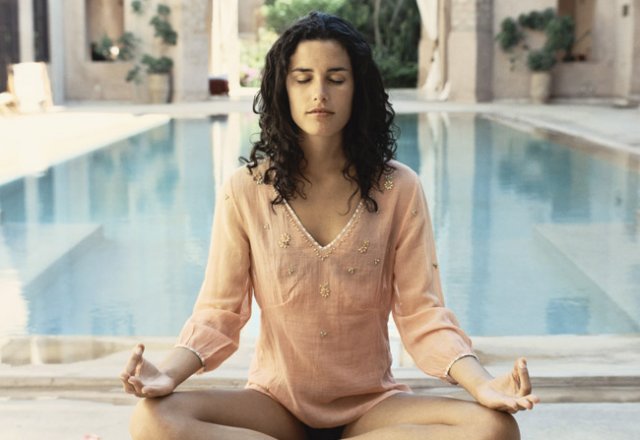
How to make yoga a habit

Make wellness a priority in 2015
Yoga teacher Emma Palmer shows us how to make wellness a priority in 2015.
So you’ve made the decision to commit to a dedicated yoga practice for 2015 as a way of either making a change or creating a new habit or to get rid of an old one.
You’ve established your ‘start date’ and you’re ready to make headway on engraining new neural pathways required to make a long-term change.
The first hurdle, of course, is getting through those first challenging 21 days. Then, you’ve done it – the worst is behind you, you’re on the home road to change and Masterville here we come.
Well, that may have been the case a few years ago, however, according to a new study from University College London (UCL), it does, in fact, take much longer than 21 days to create new habitual patterns.
This makes sense considering most years, by March/April, we find our New Year’s resolutions lingering like a ghost of the distant past.
Our yoga practice is considered a life practice, however there are times when our commitment starts to wane, become inconsistent, and before long you realise you haven’t practiced for a while. Life gets in the way, we feel we don’t have enough time and, soon, our bodies and minds start the feel the effects of not practicing.
Those age-old patterns return making us feel less tolerant and more impatient, and we miss the many benefits that a consistent practice brings.
The yoga sutras
The reality is it takes time to establish a healthy pattern of consistent practice, and this doesn’t just apply to yoga, it may also apply to other areas of our life where we have established both heathy and unhealthy habitual patterns.
There are many theories that have highlighted how and why we establish a particular habit, however the Yoga Sutras indicate that consistency of practice over a long period of time is the key.
The Yoga Sutras state that the true teachings of yoga can only be attained through consistent, skillful and conscious practice, without attachment to the outcome, over a long period of time.
So why don’t we commit to our practice, particularly when we know how good we feel when we do practice regularly? As yoga practitioners, dedication and commitment to a daily practice contributes a great deal of positive energy to all areas of our health and lives. However it is common to hear students comment on how challenging it is just to get onto the mat.
What are the blocks that are stopping us from achieving the ultimate state of health and wellbeing?
What is a habit?
So what actually is a habit and how is it defined? Habits are considered as a set behaviours, frequently performed automatically over a period of time. Consequently the mind creates a connection between the repeated cue and the corresponding behaviour, where the conscious mind, and subsequently, the conscious decision, are eliminated.
The habit is then entrenched because we become so accustomed to it that we don’t even remember doing it.
It makes sense then that the patterns and energy required to break a habit are also what is needed to create a new one.
But breaking old, unhealthy habits is extremely challenging, and the presence of new habits doesn’t necessarily mean that the old ones cease to exist.
What it does mean, is that the new habits must become more powerful than existing ones in influencing behaviour.
Does it really take 21 days to make or break a habit?
Who stated that 21 days was the magic number to make or break a habit? According to UCL, the 21 day myth was started by Dr Maxwell Maltz, a plastic surgeon turned psychologist and author of Psycho-Cybernetics.
Maltz established the 21 day figure because that was the average time it took for a patient to adjust to their new face post cosmetic surgery. He believed a minimum of 21 days was required for “an old mental image to dissolve and a new one to jell”.
More recent research conducted by UCL in 2012 contradicts this, suggesting that it does in fact take 66 days to form a new habit. Participants in this study were tracked for 84 days to measure the automaticity of a chosen repetitive behaviour. The measure of when the habit had been formed and deep rooted measure on average at 66 days. So don’t feel disheartened if you’re still working on a consistent practice well after February. Practice takes time, so look beyond 21 days andfocus on a lifestyle change rather than a quick fix.
The biochemistry of habits
Researchers have determined that habits are formed either through repetition, or by the release of dopamine from the brain – a chemical that acts as both a hormone and a neurotransmitter, and is associated with pleasure and reward as well as movement and motivation. When the habit is repeated dopamine is released, thereby reinforcing the benefit and increasing the desire to repeat that habit, even if it isn’t good for you. In that moment, the body’s biochemistry reacts with reward.
When the brain triggers these rewards, we become hard-wired to believe the habit is somehow good. This can reinforce potentially destructive behaviours and routines such as overeating, smoking, excess alcohol consumption and even compulsive use of computers and/or obsessive viewing of social media. Dopamine initializes the craving to repeat the habit over and over again. This is partly why breaking negative habits is so challenging – because in some way, the body is momentarily telling you that they actually feel good.
Conclusion
Sometimes in life we resist the very thing that makes us feel happy, healthy and alive. Old habits do die hard, however, with practice, commitment, dedication and consistency, yoga may just be the very thing that you’ve been searching for. And to your surprise, yoga may have also been searching for you.
NEXT: Yoga - the eight limbs or 22 happy habits


